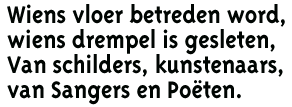


1547 Roemer Visscher born in Amsterdam, the son of a wealthy cloth merchant.Visscher joined D'Egelantier, one of the Amsterdam Chambers of Rhetoric (a late medieval Dutch literary society). Other members included Hendrik Spieghel, Dirk Volkertsz. Coornhert and >>Pieter Cornelisz. Hooft. One of the main principles of D'Egelantier was that all literary works should be written in the vernacular, i.e. in Dutch.
1584 Visscher's first daughter Anna born.
1594 Another daughter, ##Maria 'Tesselschade', born.Both Anna and Maria Tesselschade were later held in high esteem by many Amsterdam poets, including Hooft, Caspar Barlaeus and Constantijn Huygens. DaniŽl Heinsius even described Tesselschade as 'the tenth Muse'. Visscher's house along one of the Amsterdam canals, 't Saligh Roemers Huys' as it was known at the time, became the meeting place of many Dutch poets and intellectuals.
1612 Publication of Visscher's first literary work, Brabbeling (initially published without the author's permission as Lof vande mutse ende van een blauwe scheen). Brabbeling, literally meaning 'gibberish', consisted of translated poetry, epigrams and short poems. Visscher's fondness of epigrams earned him the nickname 'De Hollandse Martialis', after the Roman poet Martial.
1614 Publication of the emblem book >Sinnepoppen, Visscher's most important work.
1620 Roemer Visscher died in Amsterdam. He was buried in the Oude Kerk, where his grave can still be visited today. He is remembered in Vondel's poem Lof der Zeevaert (1623), in which the late Visscher's hospitality was highlighted:
>Click here for the translation of Vondel's memorial poem and the representation of the literary circle around Roemer Visscher by the 19th-century Dutch painter Jan Kruseman.

